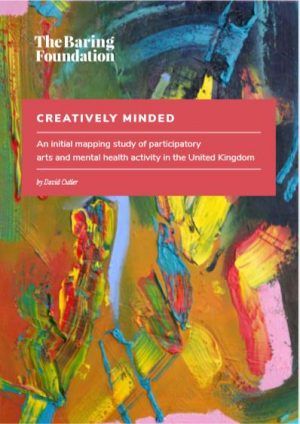Harriet Lowe and I recently had the great privilege of visiting the Prinzhorn Collection in Heidelberg. It is the most important collection of art works by people with mental health problems in the world. Its history is fascinating but also horrifying and is superbly narrated in a relatively recent book The Gallery of Miracles and Madness by Charlie English. Prinzhorn, a psychiatrist and art historian, collected work by patients from a number of countries and then wrote an influential book in 1922 called The Arts of the Mentally Ill. It took another 80 years for his dream of a museum to be achieved by which time some of the artists he collected had been vilified and even murdered by the Nazis. The collection has now expanded from 5,000 to 40,000 art works.
While we were there we also visited a supported art studio – Atelier Goldstein – in Frankfurt and learnt that these are very common in Germany. They tend to be run as the creative arm of welfare services for people who have mental health problems, learning difficulties or are neurodivergent. It has been estimated that there might be as many as 300 for people with mental health problems in Germany alone. We have made a mental note to find out what is happening regarding supported studios in the UK. I have also visited the wonderful Galerie Atelier Herenplaats in Rotterdam. They seem to me to be oases of calm and creativity. Work from the studio Frankfurt is now being collected by the Centre Pompidou.
We know that there also a number of visual arts studios in Germany attached to psychiatric hospitals as well as in the community, including the Kunsthaus Kannen near Münster (North Rhine Westphalia), which holds a small outsider art fair for galleries inside and outside Germany every year. The only similar studio we know of in the UK is probably the Bethlem Gallery which has a long-running studio for long-term patients at the South London & Maudsley.
So what else have we become aware of in Europe? Our contacts have not been at all systematic and it is particularly noticeable that they are all in Northern Europe. Also almost all of them are using visual arts. More can be found here in the membership of the European Outsider Art Association. These few examples are simply intended to demonstrate the riches that are nearby.
Ireland has a longstanding arts festival about Mental health (somewhat similar to the SMHAF in Scotland) called First Fortnight.
Belgium has both a major museum and gallery in a psychiatric hospital (a little similar to the Musuem of the Mind and Bethlem Gallery in London) and an artists in residence programme called KAOS who kindly wrote a blog for us recently.
In a similar vein, next door in the Netherlands there is both the memorably named Beautiful Distress with artists residencies and the Musuem of the Mind in Haarlem (in a former asylum from 1600s) with a sister Outsider Arts Gallery in Amsterdam. We have recently funded the British charity Outside In to collaborate with the Museum of the Mind in Haarlem over one of the most famous Dutch Outsider artists, Willem Van Genk.
Finally and perhaps most excitingly, we have recently made a grant to Community Music Wales, as part of our open round fund for men’s projects. They will be seeking to replicate the Finnish model of ‘culture houses’ for young people, described here in a blog by their founder Markus Raivio.
International exchange brought a huge amount of value to our Arts and Older People programme (2010-2019) – we are excited for the prospect of more of the same in our arts and mental health programme and more widely.
